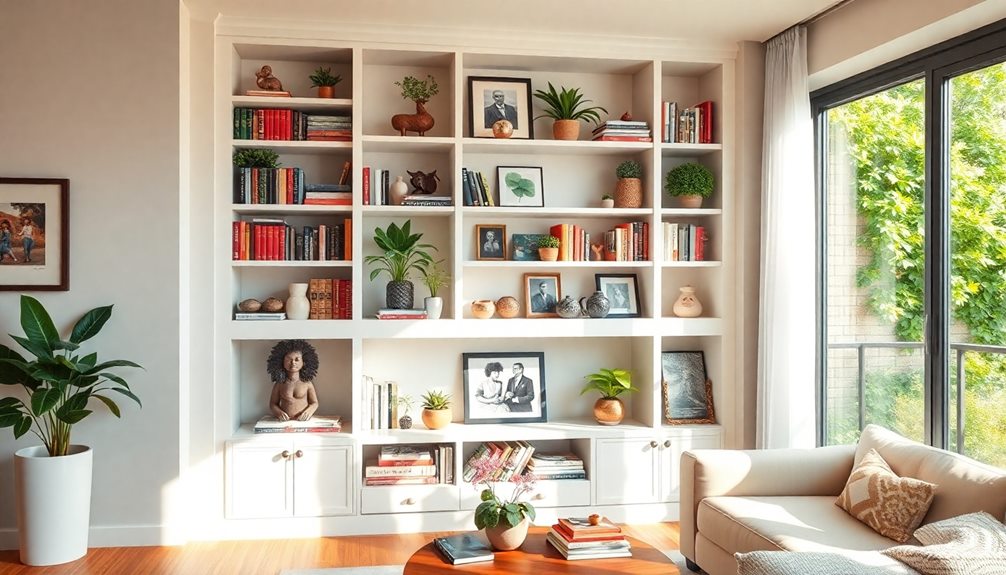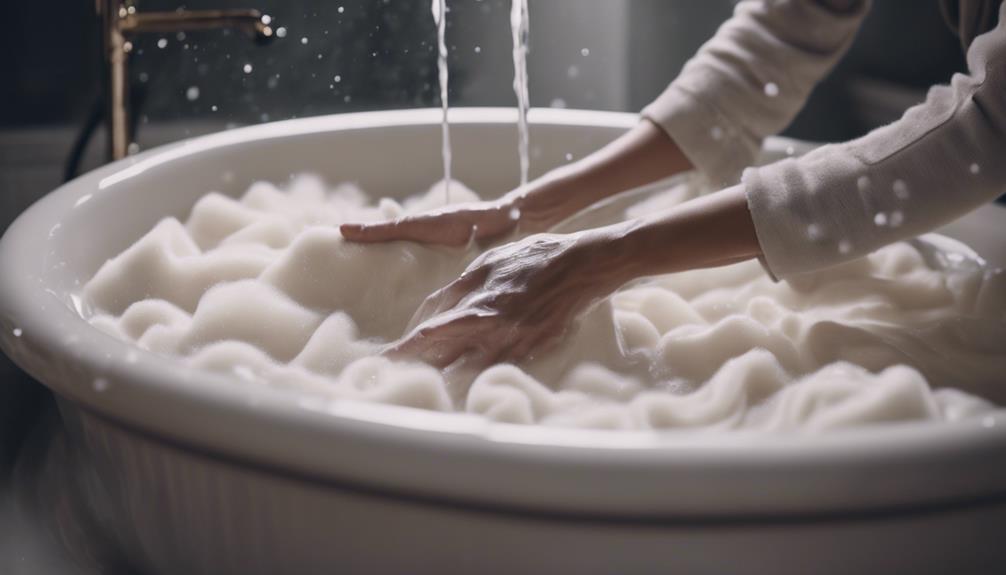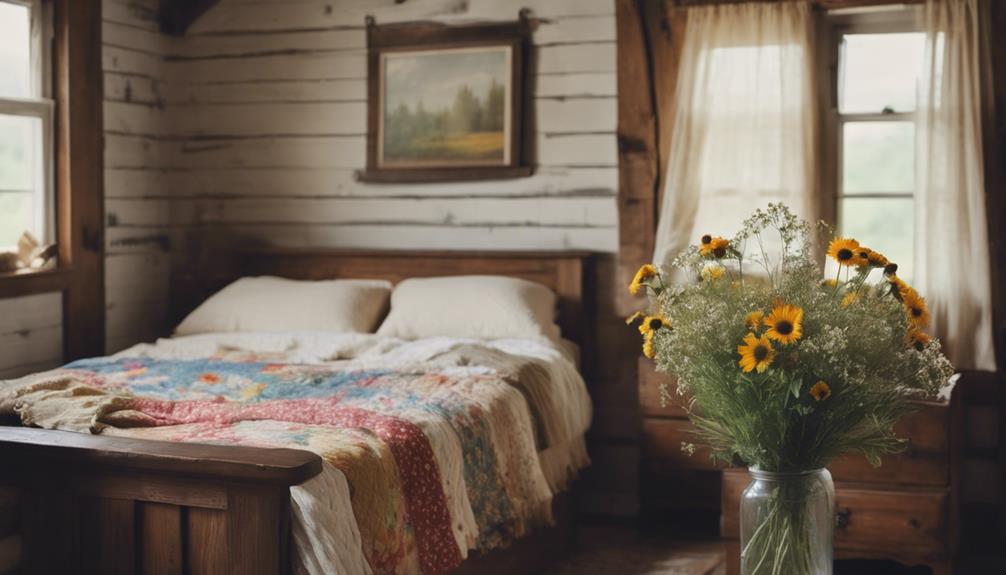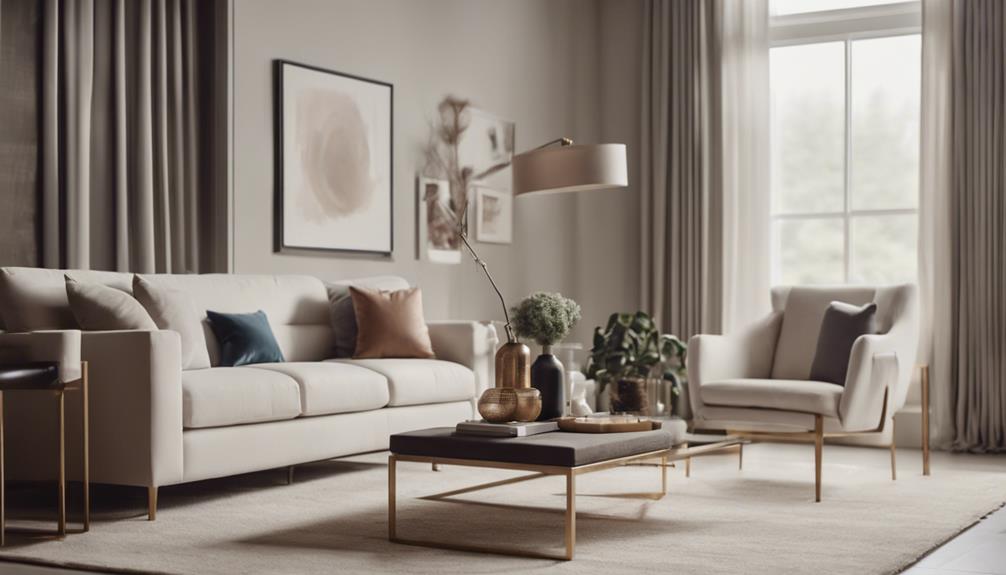Styling your built-in bookshelf can transform it from cluttered to enchanting. Start by clearing off everything for a fresh look, then assess what to keep. Focus on layering with diverse textures and heights for depth. Group items by theme or color for a cohesive vibe. Incorporate personal touches like family photos or travel souvenirs to make it uniquely yours. Remember to maintain organization by regularly decluttering and adjusting arrangements. To keep it dynamic, rotate your displays seasonally or as your interests change. Keep exploring—there's much more to discover to elevate your bookshelf styling further!
Key Takeaways
- Start with a clean slate by removing all items and dusting shelves for a fresh perspective on styling.
- Use an inventory table to categorize items by size, color, and theme, making selection easier.
- Incorporate layers of texture and varying heights to create depth and visual interest in your display.
- Group items in odd numbers and consider color blocking for a dynamic and cohesive aesthetic.
- Regularly update and rotate displayed items to keep shelves fresh and reflective of your personal style.
Importance of Shelf Styling
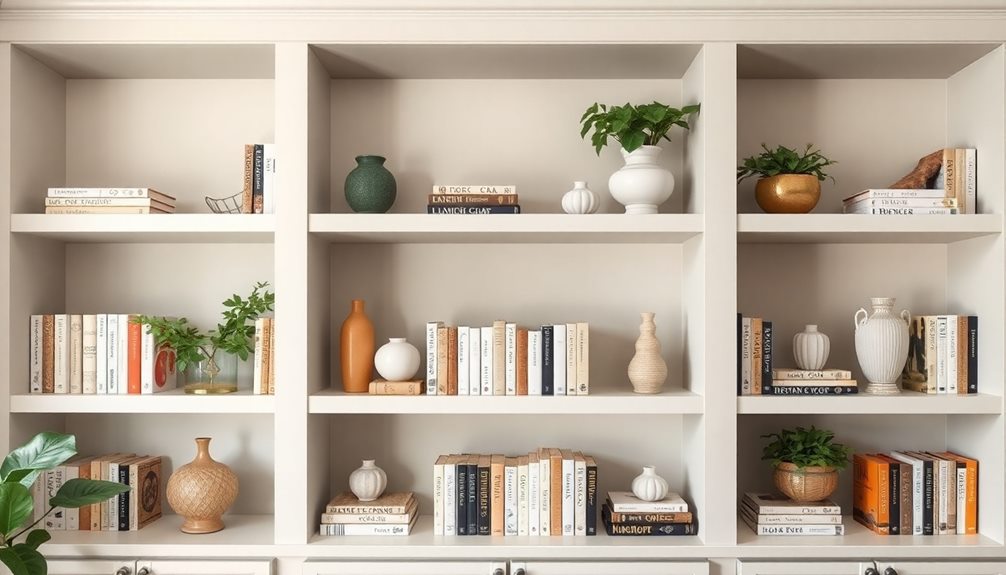
When you walk into a room, the shelves often catch your eye first, making shelf styling essential for enhancing your space's overall appeal. Properly styled shelves can serve as focal points, showcasing your personal style and interests while reflecting your personality.
By carefully curating shelf decor, you can create organized and aesthetically pleasing displays that draw attention and spark conversation. Regularly updating your shelf decor not only keeps the space feeling fresh and dynamic but also encourages creativity in your home design.
You'll find that effective shelf styling improves organization, making it easier to locate items while maintaining a tidy appearance. A well-thought-out arrangement can transform cluttered shelves into a cohesive visual statement.
Additionally, documenting your styling progress through before-and-after photos can help you evaluate design changes, showcasing your growth in home decor skills. You'll see how each adjustment impacts the overall look, inspiring new ideas for future projects.
Ultimately, investing time in shelf styling is a simple yet powerful way to elevate your space, making it a true reflection of who you are.
Creating a Blank Canvas
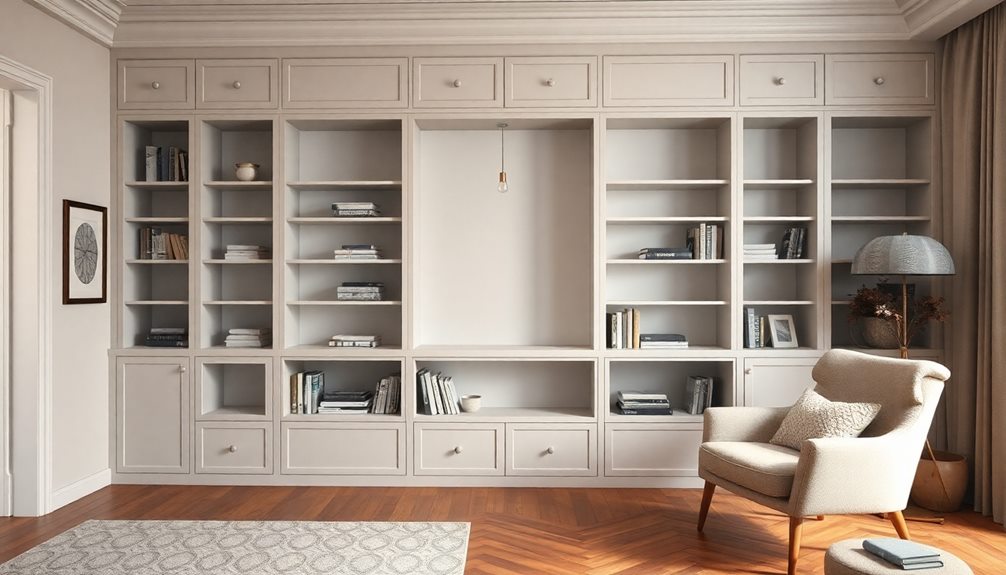
To kick off your shelf styling journey, start by clearing all items from the built-in shelves. This gives you a fresh perspective and allows for a more organized approach to styling. Once the shelves are empty, take the opportunity to clean and dust them thoroughly.
Next, here's a simple inventory table to help you visualize your items:
| Category | Items to Keep | Items to Evaluate |
|---|---|---|
| Books | Favorite novels | Coffee table books |
| Small Objects | Decorative figurines | Unique finds |
| Accessories | Picture frames | Plants |
Focusing on one shelf at a time will help maintain organization and prevent feeling overwhelmed. As you assess the empty shelves, think about how each shelf can showcase your books and small objects effectively. Document your progress with before-and-after photos; this will provide a visual reference for future design projects and help you appreciate the transformation. With a clean slate, you're ready to create a beautifully styled bookshelf that reflects your personality!
Assessing Existing Items
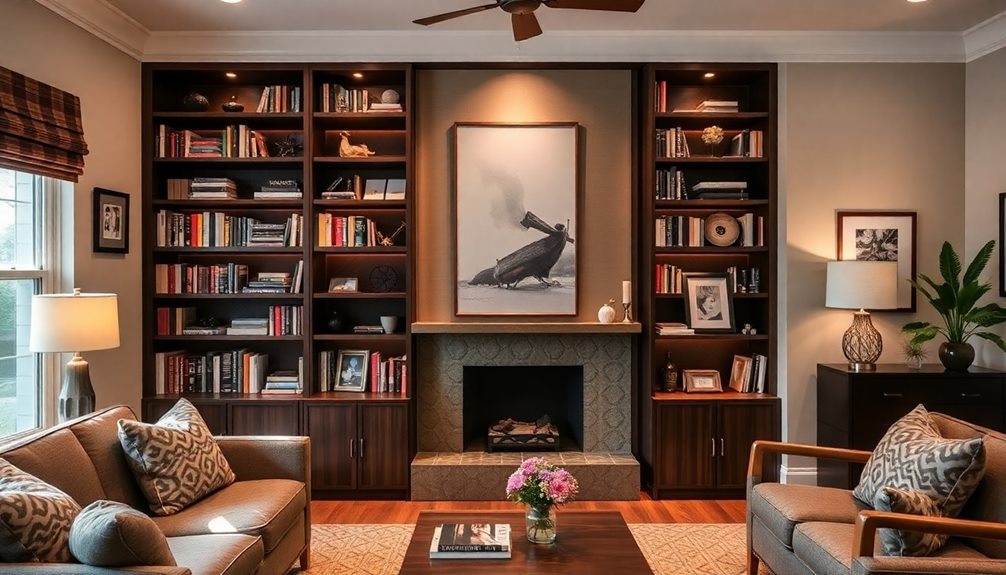
Now that you've cleared your bookshelf, it's time to evaluate your decor collection.
Group your items by size and identify any common themes or colors that stand out.
This will help you visualize how to arrange your pieces in a way that reflects your personal style.
Evaluate Decor Collection
A fresh start on your built-in bookshelf begins with evaluating your decor collection. First, clear your shelves completely to get a clear view of what you have. This allows you to assess each item with fresh eyes and consider how they can work together.
Next, group items by size and color. This simplifies the styling process, helping you see which pieces naturally complement each other and contribute to a cohesive look.
As you evaluate your decor collection, take note of any themes that emerge among your items. This will guide your styling choices and create a unified aesthetic on your shelves.
Don't forget to think about any additional pieces that might enhance your collection. Well-curated decor can add visual interest and tell a story.
Identify Grouping Themes
Start by examining your decor collection closely to identify grouping themes that resonate with your style. Consider incorporating elements from modern farmhouse design to enhance the warmth and charm of your shelves.
Remove all items from the shelves to gain a clear view of everything you have. This makes it easier to assess your items first and visualize potential arrangements. Look for common threads by grouping items by size, color, or theme. This can help streamline the styling process and create groupings that feel cohesive.
Consider the narrative you want your bookshelf to convey. Personal memorabilia, art, and books can reflect your interests and experiences, so think about how these pieces can work together.
Take inventory of your accessories, and highlight unique items that enhance the overall aesthetic. As you work through your collection, simplify it by recognizing unnecessary or redundant items.
This not only declutters your space but also leads to a more curated and visually appealing display. By focusing on grouping themes that truly represent you, you'll create a bookshelf that's not just stylish, but also meaningful.
Layering for Depth
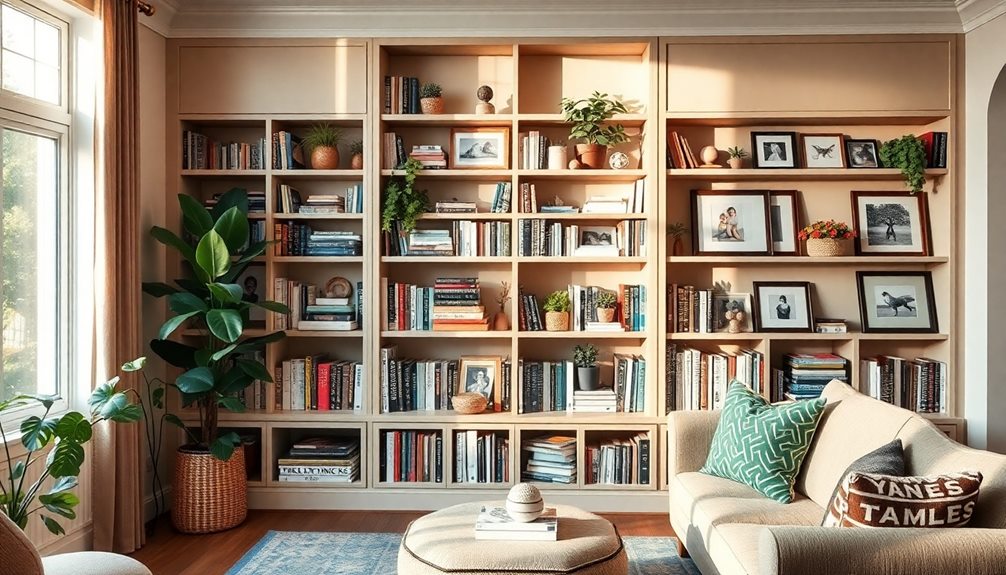
When designing your built-in bookshelf, layering for depth is crucial to achieving a visually engaging display. Start by incorporating layering textures—mix materials like wood, metal, and ceramics to create visual interest. Use larger items as a backdrop, placing smaller decor pieces in front to develop a tiered effect. This enhances the three-dimensional aspect of your shelf design.
Don't forget to include plants at varying heights, such as trailing varieties that cascade over the shelves. This introduces natural elements and breaks up the linearity of stacked items.
Speaking of stacks, consider stacking books horizontally to serve as a platform for decorative objects. This not only layers your shelf but also provides a base for smaller accessories.
For a more dynamic look, group your items in odd numbers—three or five works best. This approach guarantees that each layer contributes to the overall aesthetic without overwhelming the space.
Incorporating Personal Touches
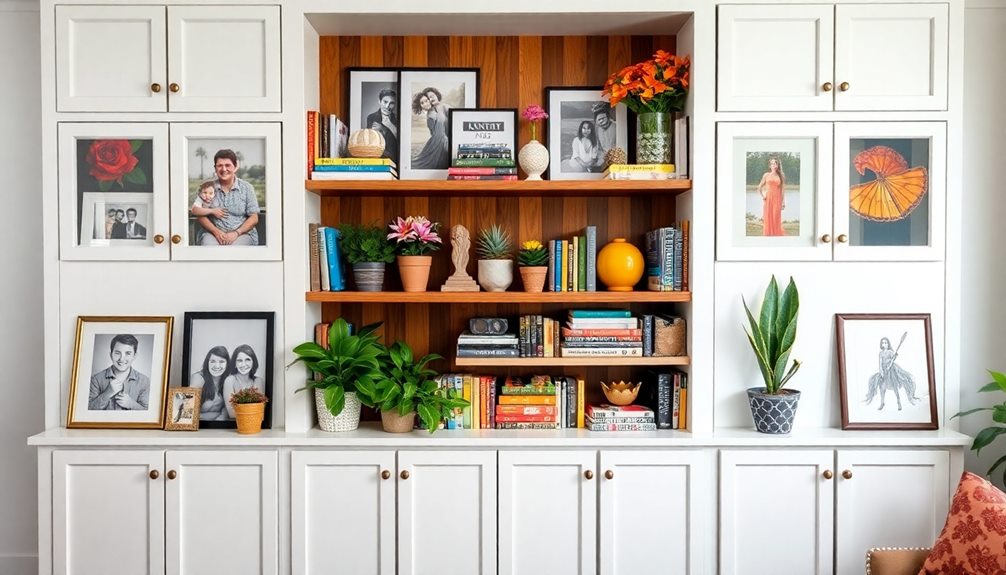
Incorporating personal touches into your built-in bookshelf transforms it from a simple storage space into a reflection of your life and interests.
Start by adding family photos in varying sizes and stylish frames. This not only enhances the aesthetic but also showcases cherished memories that tell your story.
Next, think about including personal memorabilia, like awards or certificates, alongside your favorite books. This infusion of achievement adds character and depth to your shelf styling, making it uniquely yours.
You can also mix in travel souvenirs—unique artifacts or decorative items from your adventures—that create a visually engaging narrative of your experiences.
To keep things dynamic, consider rotating displayed items periodically. This keeps your shelf feeling fresh and reflective of changing seasons or milestones.
Don't forget decorative boxes; they can serve as both storage and a stylish accent, adding layers of texture and color.
Thematic Grouping Ideas

When styling your built-in bookshelf, consider creating thematic groupings that reflect your interests, like travel or literature.
For a travel-inspired look, incorporate decor items like vintage globes and maps alongside travel guides, while also thinking about how natural materials, akin to Balinese interior design ideas, can enhance the aesthetic.
If you lean towards a literary theme, arrange your favorite novels with decorative bookends and literary quotes to bring your shelf to life.
Travel-Inspired Decor Ideas
Creating a travel-inspired bookshelf can transform your space and spark wanderlust with just a few thoughtful touches. Start by choosing a specific travel destination as your theme. Incorporate maps, postcards, and souvenirs from that location to create a cohesive display.
Consider using a variety of materials, such as wooden or metal decorative elements, to enhance the aesthetic appeal of your bookshelf, similar to aesthetic hooks and wall organization. Use books about travel, culture, and photography to reflect your interests and experiences related to your chosen destinations.
For added dimension, include decorative elements like globes, vintage suitcases, or framed travel photos. Group these items by color or style that ties into your theme—think blues and whites for a beach vibe or earthy tones for a nature-inspired look. Incorporating items of different heights can create visual interest and depth on your shelves.
Don't forget to scour local thrift stores for unique finds that resonate with your travel experiences. Consider rotating your decor seasonally or after trips to keep your display dynamic and representative of your latest adventures.
This way, your bookshelf not only tells a story but continues to evolve, enhancing the overall travel-inspired decor ideas in your home. Let your bookshelf become a visual journey that inspires you and guests alike!
Literary-Themed Shelf Arrangements
Often, a well-curated literary-themed shelf arrangement can turn your bookshelf into an enchanting conversation starter. By grouping books by author or genre, you create a cohesive narrative that showcases your reading preferences. To elevate your styling, consider incorporating decorative items that reflect the theme. Here's a quick overview of ideas to inspire your literary-themed shelf arrangements:
| Theme | Decorative Elements |
|---|---|
| Classic Literature | Vintage typewriters, muted color art prints |
| Travel & Adventure | Maps, globes, travel-related quotes |
| Contemporary Fiction | Bright art pieces, modern sculptures |
Books are usually best displayed with color coordination, unifying both the volumes and decorative elements. For a sophisticated look, arrange classic novels with muted covers alongside matching decorative objects. Don't forget to rotate your displayed books periodically, highlighting different themes or genres. This keeps your arrangement dynamic and encourages regular engagement with your literary collection. With these tips, your bookshelf can become not just a storage space, but a vibrant expression of your love for literature.
Utilizing Color and Texture
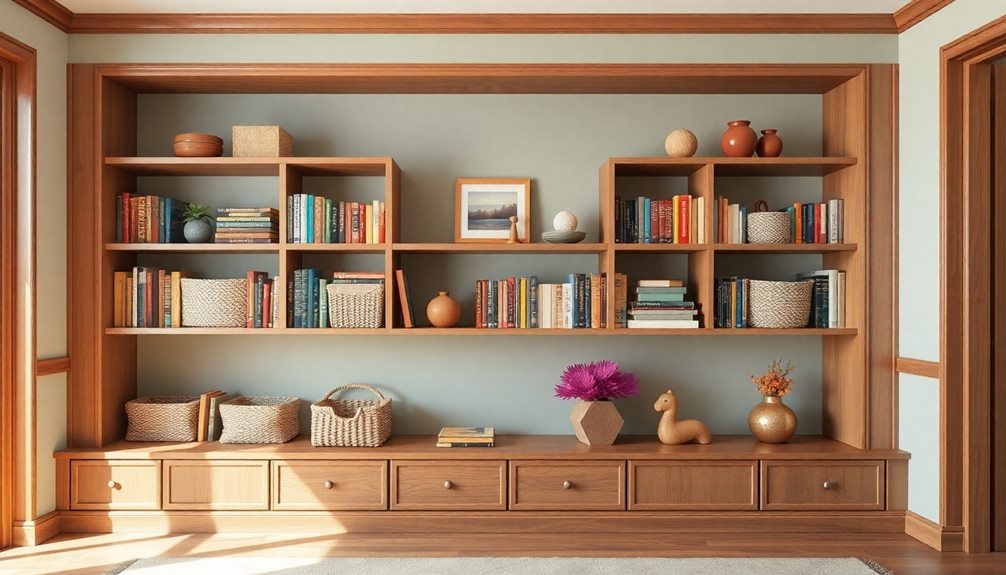
There's a world of possibilities when it comes to utilizing color and texture in your built-in bookshelves. Start by stacking your books by hue to create a visually harmonious look that enhances your room's decor. This method not only organizes but also adds a striking visual impact that draws the eye.
Incorporating a variety of textures—like wood, metal, and ceramics—creates depth and interest. Layer textured items such as woven baskets or ceramic vases alongside your books for a well-rounded, functional look.
You can also mix neutral-colored books with pops of color from decorative items to achieve a balanced aesthetic that won't overwhelm the space.
Consider color blocking, grouping items based on their color to enhance the visual impact of your shelves. This technique reflects your personal style while keeping the display dynamic and engaging.
Maintaining Organization and Balance
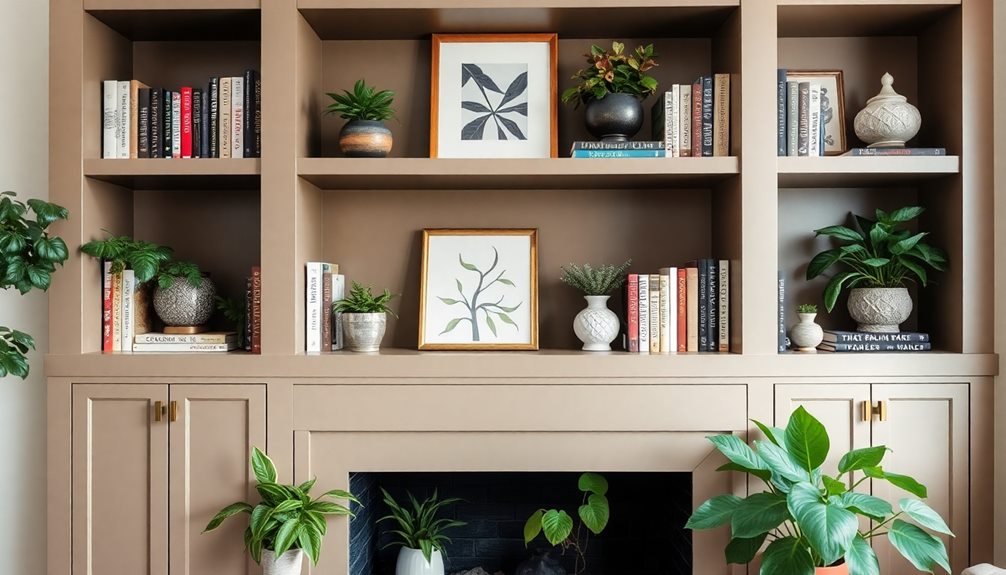
Maintaining your built-in bookshelf's organization and balance is essential for a polished look that enhances your space. Start by regularly decluttering your shelves. Remove any items that don't add value or aesthetic appeal, guaranteeing a tidy appearance.
Use baskets or decorative boxes to organize smaller items, preventing clutter and adding texture.
Next, group books and decorative objects by theme or color. This method promotes cohesion and makes it easier to achieve visual balance. Odd-numbered groupings, like three or five, work best for both books and decorative pieces. This arrangement isn't only visually pleasing but also creates a sense of harmony within your display.
Don't forget to rotate and reassess your arrangement periodically. This practice keeps your bookshelf fresh and encourages ongoing organization, preventing items from becoming static and stale.
Frequently Asked Questions
How to Style a Bookshelf Like a Pro?
To style a bookshelf like a pro, start by emptying it out. Arrange larger items first, mix book orientations, and add personal decor. Regularly refresh your display to keep it dynamic and engaging.
How to Spruce up Built-In Bookshelves?
Think of your built-in bookshelves as a canvas. Start fresh by emptying them, then layer in statement pieces, personal mementos, and greenery. Mixing heights and styles creates a harmonious display that tells your unique story.
What Is the Bookshelf Rule?
The bookshelf rule suggests arranging items in odd numbers for visual balance. Start with larger pieces, mix vertical and horizontal orientations, theme groupings, and leave empty spaces to create an engaging and cohesive display.
How to Style Shelves in 2024?
To style shelves in 2024, start by emptying them and evaluating your decor. Use a mix of sizes, arrange books creatively, and add personal touches. Play with colors and leave space for a clean look.
Conclusion
In the world of shelf styling, your creativity can truly shine. By blending personal touches with thoughtful organization, you'll transform your built-in bookshelf into a work of art that tells your story. Remember, a well-styled shelf isn't just a display—it's a window into your life, inviting others to peek inside. So grab those cherished items, layer them with purpose, and watch as your bookshelf blooms into a stunning focal point in your home!
